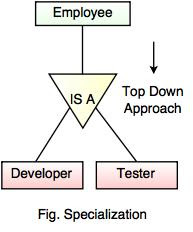Explain specialization and generalization with example.
Specialization
- Specialization is a process that defines a group of entities that is divided into subgroups based on their characteristic.
- It is a top-down approach, in which one higher entity can be broken down into two lower-level entities.
- It maximizes the difference between the members of an entity by identifying the unique characteristic or attributes of each member.
- It defines one or more subclass for the superclass and also forms the superclass/subclass relationship.
- For example:
Generalization
- Generalization is the process of generalizing the entities which contain the properties of all the generalized entities.
- It is a bottom approach, in which two lower-level entities combine to form a higher-level entity.
- Generalization is the reverse process of Specialization.
- It defines a general entity type from a set of the specialized entity type.
- It minimizes the difference between the entities by identifying the common features.
For example:





Comments
Post a Comment